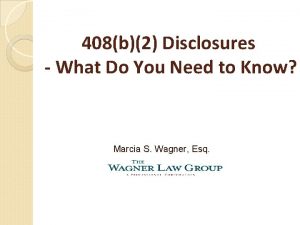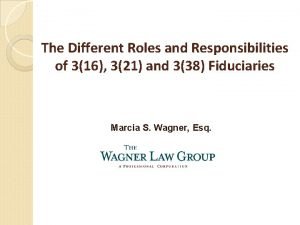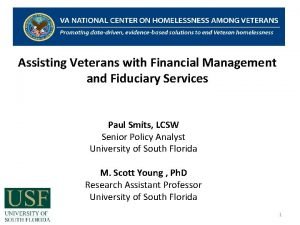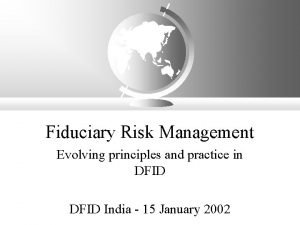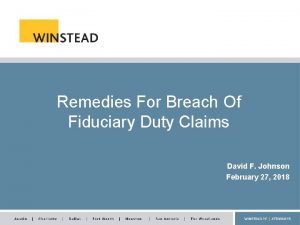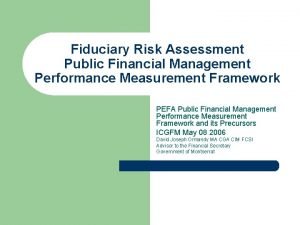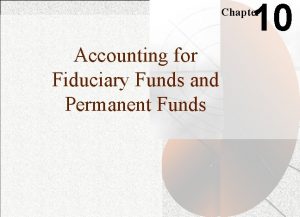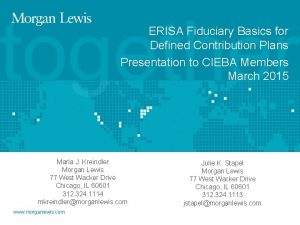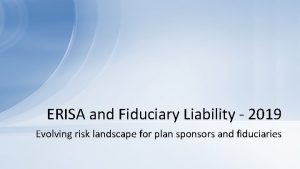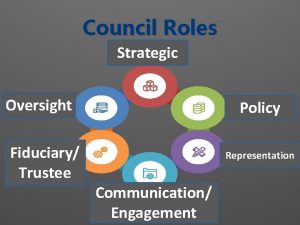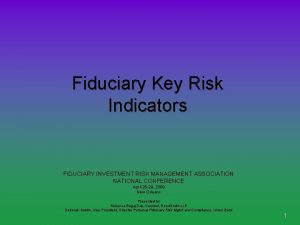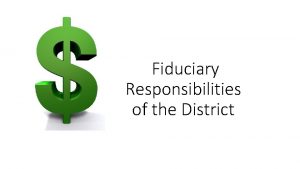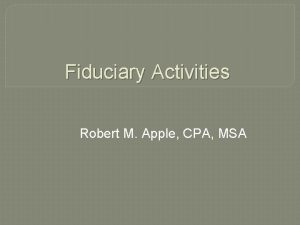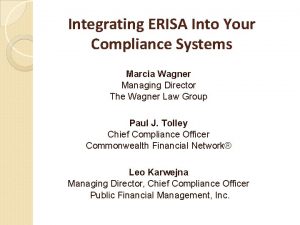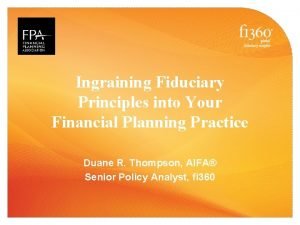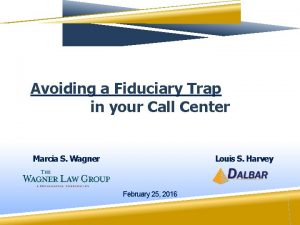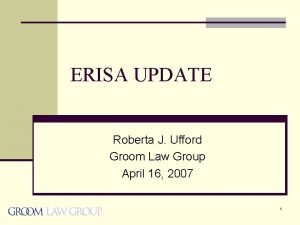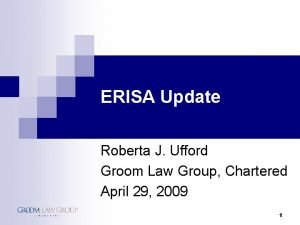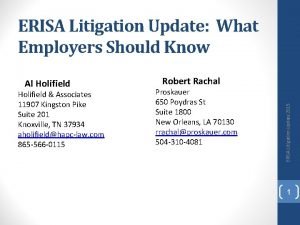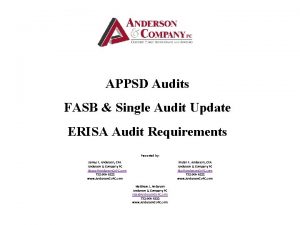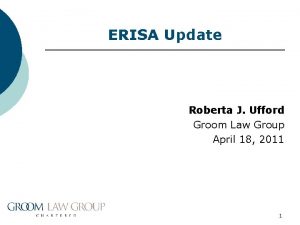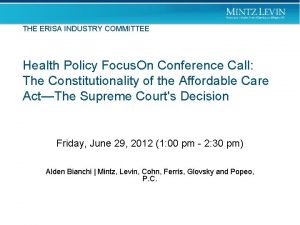Understanding your fiduciary role An ERISA Primer for

























- Slides: 25

Understanding your fiduciary role An ERISA Primer for Defined Contribution Plan Sponsors Dan Notto, ERISA Strategist, Retirement Solutions, J. P. Morgan Asset Management

What is ERISA? ERISA is the acronym for the Employee Retirement Income Security Act of 1974 – Federal law that regulates employer-sponsored retirement and welfare benefit plans – Imposes specific duties and standards of conduct on plan fiduciaries – Among other things, requires disclosures to plan participants and reporting to the government The U. S. Department of Labor (DOL) is the primary regulator The Internal Revenue Service (IRS) regulates the tax qualification aspects of employer-sponsored plans 1

Who is an ERISA fiduciary? Anyone who: – Has discretionary authority or control over the management or administration of the plan – Exercises authority or control over plan assets – Renders investment advice for a fee or other compensation, direct or indirect The following are typically fiduciaries: – Plan sponsors – Plan investment committees – Trustees – Investment managers – Persons who give investment advice to plan sponsors or participants Persons who perform only ministerial functions are typically not fiduciaries, including: – Recordkeepers – Accountants 2

Many are unaware of their fiduciary status Are yourself a Fiduciary to your organization’s retirement plan(s)? Source: J. P. Morgan Plan Sponsor Research 2015. 3

What are the responsibilities of a fiduciary? A fiduciary must: – Act solely in the interest of participants and beneficiaries – Act with the “care, skill, prudence, and diligence under the circumstances then prevailing that a prudent man acting in a like capacity and familiar with such matters would use…” (ERISA Section 404(a)(1)(B)) – Diversify the plan’s investments – Follow the provisions of the plan’s documents (unless inconsistent with ERISA) – Assure that plan expenses are reasonable – Avoid prohibited transactions Fiduciaries can be personally liable for losses for failing to live up to ERISA’s fiduciary standards 4

Prohibited transactions Self dealing: A fiduciary’s use of plan assets in his or her own interest Conflicts of interest: Acting on both sides of a transaction involving the plan Kickbacks: Personally receiving anything of value from any party dealing with the plan in connection with plan asset transactions Certain “party in interest” transactions – Parties in interest include fiduciaries, service providers, employees, plan sponsors and certain of their owners and officers – Example: The plan purchases an asset from the plan sponsor – Prohibited transaction exemptions permit certain transactions that are not considered abusive Consequences of engaging in a prohibited transaction – Potential liability for breach of fiduciary’s duties – Excise tax of 15% of the amount involved (up to 100% in some cases) 5

Examples of fiduciary acts Selecting and monitoring the plan’s investment options Hiring and monitoring plan service providers, including: – Recordkeepers – Trustees – Investment advisors Determining the reasonableness of plan fees Assuring that participants receive summary plan descriptions, account statements and other disclosures Depositing employee contributions in the plan on a timely basis – As soon as it is reasonably possible to segregate them from company assets, but no later than the 15 th business day of the month following payday – For plans with fewer than 100 employees, contributions will be deemed timely if made within 7 business days following payday 6 Assuring that fiduciaries and persons who handle plan funds are covered by a fidelity bond that protects the plan against losses due to fraud or dishonesty

Acts that are not fiduciary acts: “Settlor” functions Examples Deciding to offer a plan Benefit design, including: – Type of plan – Vesting schedule – Matching contribution formula Certain plan changes Deciding to terminate a plan 7

Co-fiduciary liability A fiduciary is liable for the breach of another fiduciary if: – He or she knows of the breach and participates in it or tries to conceal it – Through his or her own fiduciary breach, he or she enables the other fiduciary to commit the breach – He or she knows of the other fiduciary’s breach and fails to make reasonable efforts to remedy it Exception: Plan sponsor or other fiduciary is not liable for the acts or omissions of an “investment manager” (as defined in ERISA Section 3(38)) if prudently hired 8

Hiring service providers Guidance from the DOL Use an objective process designed to get information to assess qualifications, quality of services and reasonableness of fees Give each prospective service provider identical information about the plan and the desired services Consider, among other things: – Scope of services – Fiduciary status of provider – Financial condition, experience with similar size plans – Experience and expertise of key personnel – Recent legal action – References 9 Document the reasons for choosing the service provider

Outsourcing fiduciary functions Some financial professionals and other firms may provide services as fiduciaries – Investment advisor “ 3(21) services” – Investment manager “ 3(38) services” – Administrator “ 3(16) services” 3(21), 3(38) and 3(16) refer to sections of ERISA that define these roles – The retirement plan services industry uses these section numbers colloquially to describe a range of fiduciary services Hiring a fiduciary service provider—like hiring any service provider—is a fiduciary act – So plan sponsor cannot completely outsource all fiduciary responsibility – Must engage in a prudent process – Be sure the plan document permits – Understand the scope of the provider’s services: Read the fine print 10 Don’t forget about the potential for co-fiduciary liability

3(21): Investment advisor Refers to a person who is a fiduciary by virtue of providing investment advice for a fee* Does not have discretion to make investment decisions—Ultimate decision-making responsibility rests another fiduciary (e. g. , plan sponsor or investment committee) Typical services performed as a fiduciary – Recommend an investment policy and prepare an investment policy statement – Research and narrow the list of potential investment options and providers – Recommend investment options the plan’s investment committee – May provide advice to individual participants regarding the investment of their plan accounts May also provide non-fiduciary services including: – Provide insights to the plan sponsor on market trends and plan design – Assist in the preparation of service provider requests for proposals (RFPs) – Educating plan participants *(ERISA Section 3(21)(A)(ii)) 11

3(38): Investment manager Refers to a fiduciary appointed by the plan and given discretion to manage plan assets Must be a bank, insurance company or registered investment adviser that acknowledges fiduciary status in writing Examples of services – Manage a portion of a defined benefit plan’s assets (e. g. , stock fund, bond fund, etc. ) – Manage the glide path of a custom target date fund – Take responsibility for selecting, monitoring and replacing the investments options in a 401(k) plan 12

3(16): Administrator All ERISA plans must have an “administrator” which is typically the plan sponsor Fiduciary responsibilities include: – Filing Form 5500 – Furnishing disclosures to participants including § Summary plan descriptions § Fee and investment information required by the DOL’s participant disclosure rules § Periodic statements 13 Outsourced 3(16) service provider may agree to perform some or all of the administrator’s responsibilities

Shifting investment responsibility to employees: ERISA section 404(c) Permitting participants to choose the investments for their individual accounts from a menu selected by plan sponsor fiduciaries Compliance is voluntary, but most DC plan sponsors try to take advantage – Without 404(c), plan sponsor fiduciaries could be liable for participants’ investment decisions In general, requirements include: – Notify participants that the plan intends to comply with 404(c) and that fiduciaries may be relieved of losses for participants’ investment decisions – Offer a broad range of investment options (at least 3 with different risk and return characteristics) and allow participants to switch among them at least quarterly or more frequently based on volatility – Provide participants with sufficient information about the investment options, including the fee and investment information required by the DOL’s participant disclosure rules 14 Even though 404(c) protects against losses resulting from participants’ choices, plan sponsor fiduciaries are still responsible for selecting and monitoring the designated investment options

Protecting fiduciaries when participants fail to make investment decisions The qualified default investment alternative (QDIA) rules Plan fiduciaries who comply with the DOL’s QDIA rules will not be responsible for investment losses where participants did not provide investment direction A QDIA must be a target date fund, balanced fund or a managed account* Other conditions apply including: – Participants must have had an opportunity to make an investment choice but failed to do so – A notice must be provided to participants at least 30 days prior to the first investment in the QDIA and each year thereafter – Participants must be given material describing the QDIA Even though the QDIA rules protect fiduciaries when participants fail to choose investments, fiduciaries are still responsible for selecting and monitoring the QDIA – DOL’s “Tips for ERISA Plan Fiduciaries” provide general guidance *Stable value or money market funds are also QDIAs, but only for the first 120 days after participant is automatically enrolled 15

A lack of plan sponsor confidence in understanding administrative fees Please rate your confidence about each of the following when it comes to administrative fees for the plan and participants (% responding “very” or “extremely” confident) Source: J. P. Morgan Plan Sponsor Research 2015. 16

DC plan lawsuits: 100+ cases since 2006. . . and the pace of filings is quickening: More than 30 new DC suits filed in 2016* Over 300 million in settlements, including – Lockheed Martin: $62 million – Boeing: $57 million Cases will continue – More plaintiff law firms will enter the business – May find new categories of defendants to sue and develop creative new theories – DOL fiduciary rule could prompt more suits * Not including church plan or stock drop cases. If those cases were included, the total would likely exceed 60. 17

Key claims made by participants Large plan sponsor fiduciaries – Fiduciaries were imprudent by choosing higher-cost investments when cheaper ones were available given the plan’s size – Recordkeeper was compensated through asset-based revenue sharing from the funds, but as assets grew, plan sponsor didn’t renegotiate recordkeeping agreement – Used a money market fund rather than stable value which would have provided better returns for participants Plan service providers – Recordkeeper received a portion of the fees charged by managed account provider but provided little service – Recordkeeper was a fiduciary and received and kept revenue sharing thus engaging in a prohibited transaction – The crediting rate paid on stable value funds was well below the insurer’s internal rate of return Financial institution plan sponsors – Included an affiliate’s funds in the plan when it could have used better and/or cheaper funds from other providers – Engaged in prohibited self dealing when it used its own plan to “seed” its affiliate's funds 18

Key claims made by participants (cont. ) Large universities with 403(b) plans – Many of the same claims in suits involving large corporation plans including excessive fees – Use of multiple recordkeepers caused inefficiencies and higher costs – “Dizzying array” of fund options, over 400 in some cases, leads to participant confusion Church-related health care organizations (typically related to their defined benefit plans) – Because the plans were not established and maintained by churches, they could not claim to be exempt from ERISA under ERISA’s church plan exemption – Plaintiffs deserve ERISA protections – The U. S. Supreme Court announced in December 2016 that it will hear 3 cases 19

Minimizing fiduciary risk in a DC plan Establish a governance structure and procedures Identify all fiduciaries and assure that they understand their role and responsibilities – DOL examiners often ask for evidence of fiduciary training Establish and follow an investment policy statement Consistently use a deliberate process when making all decisions and document the reasons – Investments – Recordkeepers and other service providers – Participant claims 20 Regularly monitor investments and service providers

Minimizing fiduciary risk in a DC plan Hire experts in areas where fiduciaries lack knowledge or expertise Pay attention to fees – Assure that they are reasonable in light of the services received – If revenue sharing exists, understand how it is derived and used Comply with ERISA Section 404(c) and the QDIA rules Consider purchasing fiduciary liability insurance and having plan sponsor indemnify individual fiduciaries 21

Additional resources RESOURCE GUIDE White paper 22 Serves as a guide for financial advisors and their clients to help better understand manage plan sponsor fiduciary responsibilities Currently available on jpmorganfunds. com

Questions? For additional information, please contact your J. P. Morgan representative 23

Disclosures This document is a general communication being provided for informational purposes only. It is educational in nature and not designed to be a recommendation for any specific investment product, strategy, plan feature or other purposes. By receiving this communication you agree with the intended purpose described above. Any examples used in this material are generic, hypothetical and for illustration purposes only. None of J. P. Morgan Asset Management, its affiliates or representatives is suggesting that the recipient or any other person take a specific course of action or any action at all. Communications such as this are not impartial and are provided in connection with the advertising and marketing of products and services. Prior to making any investment or financial decisions, you should seek individualized advice from your personal financial, legal, tax and other professional advisors that take into account all of the particular facts and circumstances of your own situation. . Opinions and estimates offered constitute our judgment and are subject to change without notice, as are statements of financial market trends, which are based on current market conditions. We believe the information provided here is reliable, but do not warrant its accuracy or completeness. References to future returns are not promises or even estimates of actual returns a client portfolio may achieve. J. P. Morgan Asset Management is the marketing name for the investment management businesses of JPMorgan Chase & Co. and its affiliates worldwide. J. P. Morgan Funds are distributed by JPMorgan Distribution Services, Inc. ; member of FINRA/SIPC. © 2017 JPMorgan Chase & Co. All rights reserved. 0903 c 02 a 81 caf 5 a 4 24
 408b2
408b2 Understanding the role of culture
Understanding the role of culture Web role in azure
Web role in azure Rollendistanz krappmann beispiel
Rollendistanz krappmann beispiel Statuses and their related roles determine the structure
Statuses and their related roles determine the structure 321 vs 338 fiduciary
321 vs 338 fiduciary Va fiduciary hubs
Va fiduciary hubs Fidelity personal trust company fsb
Fidelity personal trust company fsb Fidiciary risk
Fidiciary risk Fiduciary indianapolis
Fiduciary indianapolis Fox rothschild fiduciary attorney summit
Fox rothschild fiduciary attorney summit Remedies for breach of fiduciary duty
Remedies for breach of fiduciary duty Fiduciary risk assessment
Fiduciary risk assessment Accounting for fiduciary funds
Accounting for fiduciary funds Fiduciary investment risk management association
Fiduciary investment risk management association Fiduciary investment risk management association
Fiduciary investment risk management association Give us your hungry your tired your poor
Give us your hungry your tired your poor Fspos vägledning för kontinuitetshantering
Fspos vägledning för kontinuitetshantering Novell typiska drag
Novell typiska drag Nationell inriktning för artificiell intelligens
Nationell inriktning för artificiell intelligens Ekologiskt fotavtryck
Ekologiskt fotavtryck Varför kallas perioden 1918-1939 för mellankrigstiden?
Varför kallas perioden 1918-1939 för mellankrigstiden? En lathund för arbete med kontinuitetshantering
En lathund för arbete med kontinuitetshantering Särskild löneskatt för pensionskostnader
Särskild löneskatt för pensionskostnader Personlig tidbok
Personlig tidbok A gastrica
A gastrica
